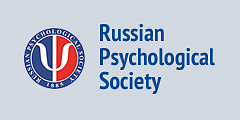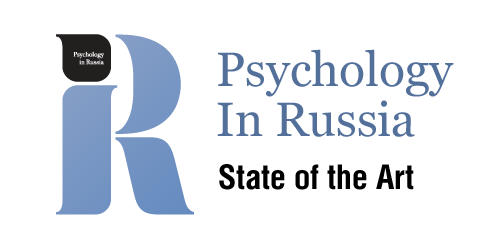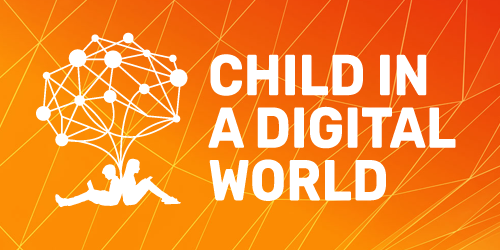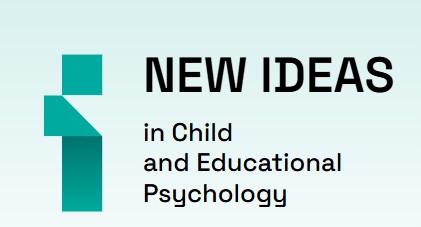Empirical studies
-
-
Relevance. In connection with the process of aggravation of religious feelings and the growth of religious consciousness due to changes in cultural patterns in modern Russia, it is important to analyze the features of the religious identity of Chechen students, which is one of the forms of self-consciousness, which is at the origins of the formation of other types of social identity of the individual, which determines the specifics of social behavior.
Objective. To characterize religious identity from the perspective of socio-psychological approach and identify its features in Chechen students.
Methods. Socio-psychological analysis of the concepts of religious identity and Muslim identity; theoretical and empirical analysis of the structure and characteristics of religious identity of Chechen students using the scale of religious orientation of G. Olport and D. Ross, methods of diagnosis of the structure of individual religion And methods of mathematical statistics. Sample. The study was conducted with 60 students of the Chechen state pedagogical University.
Results. The article presents: the definition of religious identity from the perspective of socio-psychological approach, the analysis of the concept of religious Muslim identity. The methods of research of religious identity are designated and the results of diagnostics of the Chechen students are analyzed. It is shown that students are characterized by internal religious orientation, and religion, contributing to the self-identification of young people, performs ideological, epistemological and communicative functions, acting as a model of moral norms of behavior and guidance in values. The results of the study are compared with the data of earlier studies of the religious identity of Chechen students.
Conclusion. Religion is the main value and tool of the identification process of Chechen students, filling its content with religious norms and values, answering important existential questions. Based on religious norms and values, Chechen students motivate their activities in various social spheres.
Keywords: religious identity; Muslim identity; external religious orientation; internal religious orientation; inconsistent internal orientation; Chechen students DOI: 10.11621/vsp.2019.02.105
-
-
-
Relevance. The development of the students’ general study skills is in most cases based on their ability to work with a scientific text, and it needs special examination.
Objective. The goal is to study the strategies the fourth-year students of different departments use to single out the most important information. It is also necessary to explore the criteria which students use to distinguish between the essential and inessential information while reading an explanatory scientific text.
Methods. We have used the method created by Sidelnikova and Malskaya, which constitutes a specially constructed text of an explanatory type including some essential information (the description and explanation of facts) along with some trap sentences, in their formal structure similar to definitions (sentences containing dates, surnames and the statement of the significance of the problem). 1021 fourth-year students of Moscow State University and Moscow Pedagogical University (from the pedagogical, psychological, philological departments and the department of soil science) have taken part in the examination.
Results. Less than 6 % of the students single out the description of the facts and their explanation while reading an explanatory text, which means that they learn the material and control the efficiency of learning in accordance with metacognitive knowledge based on academic conception of the structure of scientific knowledge? More than 94 % choose both the description of the facts and their explanation and the trap sentences, considering the sentences in the form of definitions, historical facts and the statements of the significance of the problem to be essential information. There have been found some statistically significant differences in the choice of the students of different departments.
Conclusion. The results show that the fourth-year students who have taken part in the study do not have academic conception of the structure of scientific knowledge and effective strategies for its mastering.
Keywords: general study skills; metacognitions; differentiation of the essential information; explanatory scientific text DOI: 10.11621/vsp.2019.02.88
-
-
-
Relevance. Eye-tracking study of reading is widely used methodology in modern psychology. But there is a lack of such studies in Russian language. Particularly, there are few eye-tracking studies of reading on early stages of acquisition of this skill.
Objectives. The main aim of our study is to describe process of reading in children 9-10 years old. We compare state of cognitive functions of children and state of their reading skills and try to describe possible strategies for mastering the skill of reading based on indicators of oculomotor activity.
Methods. 56 third graders participated in the study, mean age – 9.62 years old. The reading skills were assessed using the method “Reading regular and irregular words”. We also record eye-movements of the children during reading the corpus of sentences designed for early schoolchildren. Cognitive functions were assessed by neuropsychological assessment adapted for children of 6–9 years old.
Results. We separated the sample into two subgroups with relatively low and high state of reading skill and found differences in the state of cognitive functions and in the oculomotor activity of children in these groups. The children with relatively low reading skill often had weaknesses of executive functions, functions of visual-spatial and auditory information processing. They made more fixations and their fixations were longer than children with high state of the reading skill. A qualitative analysis of the reading of two children with dyslexia and two children with selective development of sub-lexical / lexical routes made it possible to describe the features of reading in children with the weakness of the both strategies or one of them.
Conclusion. The results obtained in the study, on the one hand, show a general interrelation between the features of reading mastering and the state of individual cognitive functions of children, and on the other hand, they indicate that there is no rigid determination of the level of reading development by the state of cognitive functions.
Keywords: ; reading strategies; dyslexia; primary school children; eye tracking; neuropsychology ; cognitive functions DOI: 10.11621/vsp.2019.02.64
-
-
-
Relevance. In psychosomatics, subjective attributions of the causes of the disease are considered as one of the components of illness representation. In somnology, the disfunctional beliefs about illness reasons are considered as a factor in insomnia perpetuation. Study of the characteristics of subjective perceptions of sleep disorders reasons in good sleepers versus sleep disorders, as well as their relationship to well-being, can help to clarify theoretical knowledge about the functions of reasons’ representations in various illnesses.
Objective. The aim was to compare the subjective reasons of sleep disorders in good sleepers, insomnia, parasomnias and sleep apnea, as well as to reveal the relationship between beliefs about the reasons of sleep disorders and anxiety and depression.
Methods. The clinical group consisted of 77 patients with sleep apnea syndrome, 18 patients with parasomnias, 105 patients with chronic insomnia who filled the Checklists of Sleep Quality, Subjective Reasons of Sleep Disorders, Screening for Sleep Apnea, Epworth Sleepiness Scale, Hospital Anxiety and Depression Scale. In 46 patients with apnea, 15 patients with parasomnias and 93 patients with insomnia, polysomnography was performed over one night. The control group included 102 people, 67 of them with periodic sleep complaints, and 33 without sleep complaints who filled Checklists of Sleep Quality, Subjective Reasons of Sleep Disorders.
Results. Good sleepers are characterized by a wide range of sleep problems’ attributions. In case of complaints for some sleep problems, the focus on emotional causes was enhanced while in case of chronic disorders, the number of reasons was narrowed to those specific for that sleep disorder. In both apnea and insomnia, subjective belief that sleep is disturbed by unpleasant sensations in the arms and legs was especially stressful for participants and was associated with depression and marginally associated with anxiety. Attribution of sleep disorders to life events was associated with a higher level of anxiety, especially in insomnia.
Conclusions. The data supports the hypothesis that some subjective reasons of sleep disorders are associated with psychological distress, regardless of the subjective and objective quality of sleep.
Keywords: somnology; psychosomatics; illness representation; sleep disturbances; sleep apnea syndrome; insomnia DOI: 10.11621/vsp.2019.02.45
-
-
-
The relevance of the study is the need to clarify what factors can determine the self-esteems of volitional traits of a person.
Objective. The empirical study of the possible influence of action control mode and action and meaningfulness of life level on person's representation about the development of his volitional traits.
Methods. 943 first-fifth year university students were asked to complete three questionnaires: Self-esteem technique of the volitional traits (V. Ivannikov, E. Aidman), Action control in planning scale (NAKEMP-90) in adaptation of S. Schapkin, Purpose in Life test in adaptation of D. Leontiev.
Results. There was a reliable relationship of the values of action control in planning scale (ACP) and general meaningfulness of life index (MLI) with three volitional traits (strong-willed, confident, bold) and total score of 20 volitional traits (TSVT). The results of 2-way ANOVA showed significant effects of Action Control and Meaningfulness of Life on the value of TSVT. The lowest TSVT values were observed in students with low values of ACP and MLI, and the highest -with high values of these indexes.
Conclusion. The results are discussed in the framework of V.A. Ivannikov’s theoretical ideas about psychological mechanisms of volitional regulation of personality, especially the role of the meaning formation in the process of transferring prompting from motive to purpose. It explains the natural connection of person`s meanings and self-esteems of volitional traits, as well as the contribution of such resource of self-regulation of human activity as action control mode.
Keywords: will; self-esteem; meaningfulness of life; action control DOI: 10.11621/vsp.2019.02.27
-
-
-
Relevance. The article discusses the possibility of a new technique for testing the professional knowledge. This is a technique of "matrix testing" (or semantic scaling). In the introduction, the author introduces a distinctive system of constructs that allows to localize a new technique in the context of a number of traditional (testing method) and non-traditional methods of assessing educational achievements and professional knowledge.
Objective. The author has set the purpose to reveal potential of "semantic scaling" for a quantitative assessment (measurement) of student competence.
Method. The method of semantic scaling was applied by the author to scale sports with the help of special scales-criteria that denote different types of interaction between athletes and motivational regulation of their activities and thus turn the technique into "psychosemantic scaling". The study was conducted on 150 senior students of the faculty of psychology of MSU, who attended a special course of the author on "Psychology of competition".
Results. The main result (the insignificant correlation coefficient between the success of this technique and the total efficiency of students during the course) does not allow to conclude that the main goal is achieved. More interesting were the additional results from the application of this technique, namely: subset of sport species, obtained by cluster analysis, allow us to talk about the "psychological classification" of these species, or at least on the "psychosemantic classification". This classification is much closer to the classical "Olympic classification", but has a number of specific features.
Conclusion. The positive result of the study can be considered a high similarity of the obtained matrices with the reference matrix (ideal model), from which it can be concluded that the technique of "psychosemantic scaling" contributes to the conceptual learning of students-psychologists – their independent work on mastering the system of concepts in this subject area.
Keywords: matrix testing; repertory grids; expert judgments; cluster analyses; conceptual mapping; conceptual learning DOI: 10.11621/vsp.2019.01.246
-
-
-
Relevance. Knowledge of the laws of emotion dynamics has not only theoretical, but also practical meaning: this knowledge is necessary to provide psychological assistance in solving the problem of maintaining relationships, to develop of emotional intelligence and regulation of emotions, to diagnose disorder of the emotion dynamics that underlies a number of affective disorders (such as depression).
Objective. Consideration of large (in terms of the number of experiments, subjects and factors studied) studies of Verduyn's group at the University of Leuven (Belgium) and Maastricht University (Netherlands). This group studied the duration of subjective experience of emotions of different types.
Methods. Review and analysis of modern Western studies of the duration of emotions and its determinants, their results and methods.
Results. The integration of data on the absolute and relative duration of emotions of certain types, as well as the contribution of such factors as the emotional intensity, the flow pattern, cognitive assessments, emotion regulation strategies, the social sharing, the cognitive processing of information about the emotional event has been done. The possibilities and limitations of the main methods of studying the emotion dynamics are revealed.
Conclusions. It is necessary to continue the research of the emotion dynamics of on the material of other age, professional, cultural groups. Also, a perspective direction is the study of the dynamics of other components (not just a subjective experience) of emotion.
Keywords: situational emotions; emotion dynamics; emotion duration; social sharing; emotional intensity; subjective experience; emotional regulation DOI: 10.11621/vsp.2019.01.230
-
-
-
Relevance. The problem of self-esteem contingenciesis currently less studied empirically than the level and the stability of self-esteem. But at the same time self-esteem contingencies is verypromising topic that allows to better understanding the problems of the psychological well-being and personal maturity of the adolescent.
Objective. The study is devoted to the connection of such types of self-esteem contingencies of adolescent as self-esteem based on competence, self-esteem based on teacher approval, self-esteem based on parental approval and compensatory self-esteem with various aspects of adolescent well-being and satisfaction of basic psychological needs by parents.
Methods. 223 adolescents were recruited for the study. Techniques were filled during school lesson. It was used Rosenberg’s self-esteem scale, the multidimensional scale of schoolchildren’s life satisfaction, the scale of basic psychological needs satisfaction in family and an author’s scale for diagnosing self-esteem contingencies.
Results. It was shown that the types of self-esteem contingenciesmake a different contribution to psychological well-being. Self-esteem based on competence contributes to self-satisfaction, self-esteem based on the approval of parents - family satisfaction, and self-esteem based on the approval of teachers - satisfaction by school. Compensatory self-esteem although leads to self-satisfaction, hinders satisfaction with family and school. At the same time, adolescents whose parents satisfy their basic psychological needs are more satisfied and have more authentic types of self-esteemcontingencies.
Conclusions. The self-esteem based on competence and self-esteem based on obtaining approval and support from significant people are more authentic, healthy and contributing to psychological well-being than compensatory one. The findings provide grounds for adolescent’s training aimed at developing psychological competencies that promote self-esteem such skills of constructive thinking, formulation and advocacy of their position, self-evaluation and coping with distress. As well as for counseling with parents and teachers to build relationships based on the provision of autonomy, support and respect for adolescents.
Keywords: contingencies of selfesteem; self-esteem; subjective well-being; basic psychological needs; adolescents DOI: 10.11621/vsp.2019.01.214
-
-
-
Relevance.The effects of self-organization of subjects and groups in their joint activities are not well understood. The purpose of the work is to analyze and systematize the facts of manifestations of self-organization in the professional activity of people in a limited social space and historical time (in organizations, in a profession, in professional specialization, etc.).
Objectives. 1) A description of the facts of self-organization as a phenomenon of “psychological niches” in the models of the labor activity of subjects in similar and in different areas. 2) Identification of the determinants of the effects of self-organization of human activity.
Method. Analysis and synthesis of diagnostic data by the method of 16 PF R.B. Cattell, more than 700 professionals (drivers, private security guards, heads of departments of large industrial enterprises) obtained in the author’s studies (1994–2017), and more than 400 civil servants in the diagnostic data in 1995 and 2000, by the method of 16 PF.
Results. It is shown that the personal characteristics of the subjects are associated with their professionally important qualities, typical psycho-physiological states, value orientations, and meanings of work. Self-organization in the professional activity of individual subjects and groups as a phenomenon of “psychological niches” is a manifestation: not of a single, but of a particular and typical; the multi-level relationship of social, psychological and biological adaptation mechanisms of interacting people in a dynamic social environment; “Multipolarity” of high activity areas of subjects, time consistency of periods of their interactions; effects that are more evident not in the productivity of people’s work, but in satisfaction with it, etc.
Conclusion. Finding ways to manage the processes of group self-organization of labor subjects, enhancing the positive effects generated by human interactions, and stopping (weakening, correcting) negative ones can contribute to the development of new resources for increasing the productivity of individual and collective labor.
Keywords: psychological niches; social group; profession; success; phenomena; time and space; subject; specialization DOI: 10.11621/vsp.2019.01.195
-
-
-
Relevance. The relevance of identifying methodological problems in the study of bilingualism and its impact on individual and social processes is due to the economic, political and socio-psychological characteristics of modern multicultural and multilingual societies. The special significance of the study of bilingualism acquire in the Russian language context. It is characterized by the need to find a balance between raising the status of the Russian language (as the main unifying factor of civil identity) and the development and preservation of the languages of the peoples of Russia (as an important component of the ethnocultural identity of their representatives).
Objective. The work is aimed at the analysis of the main methodological problems that arise during the research of bilingualism, identifying its impact on cognitive processes and the relationship of bilingualism with ethnocultural identity.
Method. From the point of view of the system approach and cultural-historical psychology, a critical analysis of studies of bilingualism, its impact on cognitive processes and the relationship with ethno-cultural identity was carried out.
Results and conclusions. Methodological problems that complicate the study of bilingualism, systematization and generalization of their results, and the application of the results in various spheres of social practice are identified. A number of methodological challenges need to be overcome in the field of studying the impact of bilingualism and multilingualism in order to obtain valid and reliable research results and implement practical, socially significant tasks in the field of preserving the languages of the peoples of Russia along with strengthening the status of the Russian language. The need for interdisciplinary studies of bilingualism and its impact on cognitive processes and ethnocultural identity based on the application of a systematic approach, including in the Russian multilingual context, is shown.
Keywords: bilingualism; multilingualism; ethnocultural identity; cognitive processes; Russian language; national languages of Russia DOI: 10.11621/vsp.2019.01.174
-
-
-
Relevance. It is one of very important tasks of modern neuroscience to investigate the psychological and psychophysiological mechanisms of body orientation processes. Particularly due to the growth in use of visualization and simulation technologies (virtual reality, projection displays, aircraft simulators). The application of such systems is often associated with mismatch between different sensory signals. One of the phenomena resulting from this mismatch is the self-motion illusion – the perception of own movement by a motionless person observing a moving visual stimulus occupying a large part of field of view.
Objective. Investigation the role of optokinetic nystagmus in self-motion illusion. The virtual optokinetic drum rotating at 30, 45 and 60 deg/s was used as a stimulus. The drum was presented using CAVE virtual reality system. 17 healthy participants took part in the experiment. The slow phases of nystagmus during self-motion illusion perception were analyzed.
Results. The more the drum rotation speed, the more the illusion intensity and slow phases duration. Also the disturbances in slow phase realization led to increase the illusion intensity. The restoration of nystagmus reduced the illusion. Thus it was found that optokinetic nystagmus is a component of a human space orientation system and the nystagmus also adjusts the illusion perception. The effectiveness of application of CAVE virtual reality system in complicated cognitive processes investigation was proved.
Keywords: visual perception ; vection; virtual reality; eye movements; optokinetic nystagmus DOI: 10.11621/vsp.2018.04.135
-
-
-
Relevance. Brain-computer interface (BCI) technology is widely employed in studies focused on possibility of substitution of human verbal and motor communication channels when such channels are lost due to stroke or trauma. One of the most promising examples of BCI technology is P300 BCI – a system based on P300 component of visual evoked potential. Visual stimulation plays a key role in P300 BCI concept, and it is thus important to explore the influence of visual stimuli environment on user’s eye movements and BCI performance.
Objective. The objective was to explore the influence of the main components of P300 BCI visual environment, namely matrix stimuli size and spacing, on the movements of user's eyes during typing, the accuracy of typing, and the amplitude and latency of P300 component.
Methods. Sixteen healthy subjects were recruited for the study. Each subject participated in five experimental sessions, where P300 BCI matrix stimuli size and spacing varied from 1.22 and 0.73 to 2.43 and 1.45 degrees of visual angle. During each experimental session, subjects were typing in a certain text sequence using the BCI while their eye movements and EEG were being recorded.
Results. We found that the stimuli size significantly affected certain characteristics of user’s eye movements. The stimuli size and spacing, however, had no significant effect on the accuracy of the typing and the amplitude and latency of P300 component.
Conclusions. The results of the study can prove to be beneficial to the development of efficient visual stimuli environments for P300 BCI.
Keywords: brain-computer interface; BCI; speller; P300; eye movements DOI: 10.11621/vsp.2018.04.120
-
-
-
Relevance. The quality of motivation characterizes the nature of urges. It is manifested in how much the motivation of a particular activity is connected with its process (intrinsic motivation) or with an alienated result (extrinsic motivation), or with intermediate types between them (E. Deci, R. Ryan). In the present study we examine how the quality of motivation of students' learning activity is associated with the experiences of pleasure, meaning, effort and void as their absence (in light of D. Leontiev’s three-dimensional model of activity-related experiences).
Objective. We aim to reveal relationships between the quality of motivation of learning activity and experiences related to this activity.
Methods.We used Activity-related Experiences Assessment inventory (AREA) to measure experiences in leisure and study, and Universal Perceived Locus of Causality Scale (UPLOC) to assess the quality of motivation. The correlation study was conducted on students sample of 17-24 years (M=18.35; SD=1.00).(N = 357).
Results. The connection of the pleasure experience in learning activity with its motivation increases monotonously when moving from controlled (external) to autonomous types of motivation, changing the minus sign to a plus; the void experience demonstrates reverse pattern. The meaning experience in general reveals similar dynamics to pleasure, but with some differences. The effort experience is insignificantly related to the most autonomous and least autonomous types of motivation, showing a significant positive relationship with the intermediate types of motivation in the middle of the autonomy continuum.
Conclusion. Significant correlations were observed between different types of motivation and experiences related to the same activity and nonsignificant and/or weak correlations between types of motivation and experiences related to different activities.
Keywords: self-determination theory; experience; the quality of motivation; intrinsic motivation; motivation continuum; extrinsic motivation DOI: 10.11621/vsp.2018.04.106
-
-
-
Relevance. The growing interest to studying foreign students and the creation of a favorable educational environment for them makes urgent to study the strategies of sociocultural adaptation of representatives of different cultures.
Objective. Identification of the coping strategies features and differences in the scales of sociocultural adaptation among foreign students, depending on their belonging to culture.
Methodology. Two questionnaires were used: the "Revised Sociocultural Adaptation Scale (SCAS-R)" (J. Wilson) and "Strategic Approach to Coping Scale - SACS" (Vodopyanova and E.S. Starchenkova). The study involved students from the CIS countries (Uzbekistan and Kazakhstan, n = 65) and from China (n = 39), studying in Russian universities.
Results. Representatives of the CIS countries revealed dominance of the indirect and passive (cautious model of behavior) coping strategies. Prosocial coping strategy (seeking social support and entering into social contact) dominates among students from China. Also differences between groups on academic adaptation and the level of knowledge of the Russian language were found.
Conclusions. Representatives of the highly contextual and reactive culture (Chinese students) mostly difficult adapt to the specifics of education, the requirements of higher education and communication in the native language of the host country. The same type of culture underlies the formation of a prosocial coping strategy. Representatives of polyactive and polychronic culture (students from the CIS countries) are dominated by indirect and passive coping strategies.
Keywords: culture; coping strategies; behavior model; sociocultural adaptation; adaptation scales DOI: 10.11621/vsp.2018.04.89
-
-
-
Relevance. 90thXX century is a very dramatic period of modern Russian history. During this period, dramatic changes have been in different spheres (economic, political, international etc.) in Russia, also values and social norms have changed dramatically. Memory lane and representations of this period influence on their representation of modern times. Therefore, it is very important to investigate historical memory of this period.
Objective. The goal of the study is to investigate psychological aspects of 90th’XX century in Russia historical memory and to compare contemporaries’ associations with youth’s associations with the epoch of 90th.
Method. Questionnaire “Representations of 90thXX century in Russia” (E. Sinelnikova)
Sample. 154 participants, 60 participants at the main stage of the study: 29 participants youthful age (mean age – 19 years), 31 adulthood, contemporaries of 90th(mean age – 52,1 year).
Results. The most frequent associations with 90thare financial crisis (devastation), deficit, deliberation, corruption, and perestroika (transformation in different spheres of society. Young participants associated the 90thwith corruption statistically significant more often than contemporaries of 90th. 90th’contemporaries associated 90thwith perestroika statistically significant more often than students. The most important sources of information about 90thare: experience (for contemporaries), TV, films, newspapers and journals. Internet is an important source of information about 90thonly for the young people.
Conclusion. 90thXX century in Russia in young people’s representations are more associated with crime and riots. In contrast, in contemporaries’ associations the epoch is more associated with transformations in different spheres of society and economic problems.
Keywords: historical memories; 90th XX century in Russia; associations DOI: 10.11621/vsp.2018.04.74
-
-
-
Relevance. The problem of finding the meaning of human existence is relevant at all times and in all Nations. The study of this problem has a pronounced interdisciplinary character. In the presented work interests of psychology of art, semiotics of cinema, psychology of religion, ethics intersect, and for processing of the received data the modern mathematical apparatus of multidimensional statistics is used.
Objective. Based on the perception of the film on the Buddhist theme to explore the depth of its understanding by a group of young Russians: to highlight the system of personal constructs (Kelly) perception of the film; to determine the cognitive complexity of the group consciousness of respondents-viewers; to analyze personal meanings that have arisen in different viewers with a particular understanding of the film.
Methods. We used methods of psychosemantic research using the method of triadic choice J. Kelly and the subsequent scaling of characters of the movie and the added roles on the personal designs made by respondents. The respondents, 38 graduate students, undergraduates and students of different faculties of Lomonosov Moscow State University.
Results. Application of the method of triadic choice G. Kelly made it possible to reveal a system of personal constructs and on their basis to build a semantic space, set by the basic categories-factors, through the prism of which the perception and awareness of the film. Received 8 interpretable factors, showing the elements of the fabric of the film and made the focus of understanding of the respondents: "Youth, inexperience — Wisdom, maturity", "Selfishness — Humanity", "Focus on the sacredness — Focus on secular life and society," "Passivity, inertia — Active life position", "Rationality — Following the passion", "Openness to experience — Conformism", "Afflicted, miserable — Enjoying life", "Masculinity — Femininity".
Conclusions. Viewers of a feature film realize its meaning in different ways and at different levels. Some are aware of it at the level of the storyline and evaluation of the characters; others are aware of the philosophical, existential meaning of the work and relate it to their spiritual quest. The work of art as a carrier of the meanings inherent in it requires the viewer to actively comprehend, initiates the work of thought, counter spiritual creativity of understanding.
Keywords: psychology of art; meaning; psychosemantics ; personal constructs; Buddhism ; empathy DOI: 10.11621/vsp.2018.04.54
-
-
-
Relevance. There is no understanding of the role of risk perception in medical decision-making, as well as the cognitive representations and implicit theories of risk of doctors. The concept of an intellectual-personal human potential helps us investigate the links between those levels of risk perception and the specifics of decision-making.
Objective. The hypothesis about the relationship between cognitive representations of risk, the preference towards certain choices in verbal tasks, and the engagement of implicit risk theories in the regulation of choices was tested.
Methods. 103 people aged 21-73 years participated, 59 doctors, and 44 realtors. Medical Risk Scale (SHMR, MRS), Cognitive Risk Representations Inventory (CRR) and Implicit Risk Theories Questionnaire (ITR) were applied.
Results. Risk representations are weakly related, though the variables are more integrated within the same level. The differences between the groups were found in: some implicit risk theories; average risk assessment; estimates of the riskiness of situations and the likelihood of a negative outcome. The groups also differed in preferences of risk reduction strategies, depending on a subjective riskiness. Thus, the inventories reflect different levels of risk perception, mediated by the professional specifics of the participants. Among doctors evaluation of riskiness of the situation is linked with the lack of control; their implicit risk theories, in general, have little relationship with the representations of specific risks.
Conclusion. Implicit risk theories and cognitive representations of risks appear as different levels of procedural regulation of decision-making; Inventories we developed are good tools for diagnosing representations of medical risks.
Keywords: dynamic regulative systems; decision making; risk; cognitive representations; medicine professions; implicit theories DOI: 10.11621/vsp.2018.04.32
-
-
-
Relevance of the study is due to the need for more detailed researching of categorization of synonymous ranges of names of basic emotions by the energy characteristics “intensity” and “power”.
Objective. Construction of circular categorical scales of the energy characteristics “intensity” and “power” in the spherical 6-dimensional model of emotions and analysis of language organization of the semantic structure of perception of their names.
Methods. Psychophysical method of revealing mechanisms for structuring semantics in linguistic consciousness based on a neuropsychological spherical model of vector coding of emotional-cognitive operations of detection and differentiation of signals E.N. Sokolov. Method of direct supra-threshold measurement of the subjective value of semantic differences between the names of emotions. Method of multidimensional scaling ALSCAL of subjective differences. The method of modeling the subjective semantic structure in the form of a spherical 6-dimensional Euclidean space. Method of measuring subjective characteristics in the form of circular scales in 2-dimensional subspaces. Methods for grouping and segmention lexical units based on the threshold values of their semantic differences.
The experiment involved 152 people aged 19 to 22 years.
Results. Circular scales of energy characteristics of «intensity» and «power» of emotions are constructed in the spherical 6-dimensional model of the semantic structure of the names of emotions by the combination in pairs of distinctive features-axes “inhibition/excitation” – “variability/stability” and “closeness /openness” – “acceptance/rejection” respectively. 8 and 10 categorical groups of synonyms are highlighted on the “intensity” and “power” scales with gradual values “norm” – “deviation from the norm”. The categories of “intensity” and “power”, expressing a high degree of manifestation of emotions, prevail. The general content for all members of each of the synonymous series on the “intensity” and “power” scales is indicated through their enumeration.
Conclusions. The mechanism of semantic grouping of the names of emotions into categorical classes and segmentation them among themselves has a uniform character based on the computation of differences and belongs to the energy characteristics “intensity” and “power” of emotions as well as the qualitative characteristic of the tone.
Keywords: multidimensional scaling; vector psychophysiology; the subjective semantic circular scales “intensity” and “power” in the spherical 6-dimensional space; names of emotions; categorical property of circular scales DOI: 10.11621/vsp.2018.03.76
-
-
-
Relevance. The relevance of the research is caused by the need of more detailed studying of the emotional and personal well-being of modern students for the purpose of rendering psychological assistance to them on its optimization.
Objective. The work purpose — the analysis of various aspects of emotional and personal well-being of students. Methods: "Self-assessment of Emotional and Personal Well-being (SEPWB)" of G.A. Glotova and L.V. Karapetyan, "Social and psychological adaptation" of K. Rogers and R. Diamond and "Attributional Style Questionnaire" of M. Seligman.
Samples: the main sample - students (n=430), comparison samples – non-student youth (n=608) and convicts (n=99).
Results. By a method of SEPWB it is shown that students on set of parameters of a self-assessment of emotional and personal well-being occupied an intermediate position between the group of non-student youth where estimates are higher student's and group of convicts where estimates of emotional and personal well-being the lowest; in a number of parameters of a method of SEPWB age distinctions between "younger" (17-20 years) and "senior" (21-25 years) student's groups are received; there were no significant differences between the female and male subgroups of students in direct comparison without taking their age into account, but when divided into two age subgroups (17-20 and 21-25 years old), gender differences were observed; a number of correlations of parameters of the SEPWB method and indicators of "Social and psychological adaptation" method of C. Rogers and R. Diamond and "Attributional Style Questionnaire" method of M. Seligman were obtained; four types of the students differing with the level of a self-assessment of emotional and personal well-being on the basis of the SEPWB index – two extreme types and two intermediate are allocated: students with the SEPWB high index, with the increased index, with the reduced index and the low index of SEPWB.
Conclusions. The results confirm the possibility of using the "Self-assessment of emotional and personal well-being" method for studying the age and gender differences between students, as well as characteristic types of experience and assessment of their inner well-being.
Keywords: emotional and personal well-being; self-assessment; psychological correlates; age and gender differences DOI: 10.11621/vsp.2018.03.60
-
-
-
Relevance. The necessity to research the self-determination of adolescents in the context of significant socio-cultural changes in the Russian Federation at the beginning of the 21stcentury.
Objective. Study of the value and sense orientation of high school students in modern Russia at the stage of preliminary professional self-determination in adolescence.
Methods. Method of studying personal professional perspective (PPP) by N.S. Pryazhnikov; content analysis.
Sample: 240 pupils (133 female, 107 male) of 9th-11thgrades of Moscow schools, aged 14-17.
Results. An analysis of the responses of adolescents to the questions of the methodology of the PPP showed: 1) In 72,5% of answers high school students perceive honest labor as a value; 2) In 81,7% of answers adolescents recognize the necessity and value of professional education after school; 3) In 62,8% of answers the respondents express doubts, and the authors of 23,3% answers deny the value of complicated and expert labor in Russia; 4) 53,3% of adolescent’s answers reflect the wish to leave Russia or thoughts of such possibility.
Conclusions. 1. In the hierarchy of values and sense orientations of modern adolescents in the area of preliminary professional self-determination, the most expressed values are self-development, qualitative education, career achievements, personal success, the perspectives of professional development and decent wages. 2. The adolescents demonstrate a high level of orientation in the current social and economic situation (the economic crisis in Russia) and admit that positive changes in society should be determined by the recognition by society of the value of complicated and skilled labor, the value of honest labor and the value of labor and education exactly in Russia. 3. The data of the study contains widely represented answers without justification, which may reflect the status of the moratorium in the value-sense self-determination of adolescents in the area of labor and vocational education. 4. The current economic situation in Russia is perceived by the surveyed adolescents as unfavorable. More than half of respondents consider the possibility of getting an education and/or moving to a permanent residence abroad as a variant of their professional future.
Keywords: older adolescents; personal professional perspective; values; value and sense orientation; preliminary professional self-determination DOI: 10.11621/vsp.2018.03.37
-









